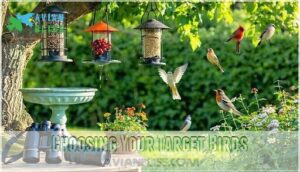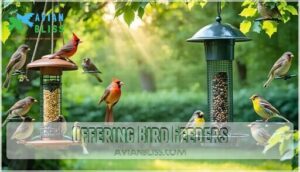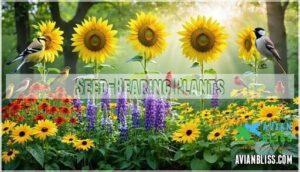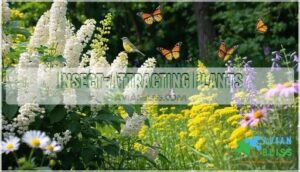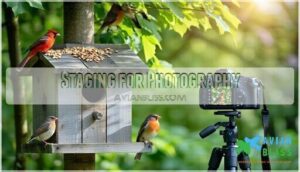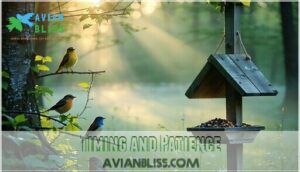This site is supported by our readers. We may earn a commission, at no cost to you, if you purchase through links.
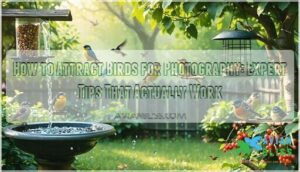
Start with multiple feeders filled with nyjer, sunflower seeds, and suet, positioning them near natural perches like dead branches or fence posts.
Add a clean water source—birds can’t resist fresh water, especially with gentle movement from a dripper.
Plant native berry bushes and seed-producing flowers to provide natural food sources year-round.
Create dense shrubs for shelter, making birds feel secure while you photograph from a comfortable distance.
The secret lies in understanding each species’ specific preferences and building their trust over time.
Table Of Contents
- Key Takeaways
- How to Attract Birds for Photography?
- Choosing Your Target Birds
- Providing Water Sources
- Offering Bird Feeders
- Planting Natural Food Sources
- Creating Shelter and Nesting Sites
- Staging for Photography
- Camera Setup and Settings
- Timing and Patience
- Frequently Asked Questions (FAQs)
- How to bait birds for photography?
- How to find birds for photography?
- What camera setting is best for bird photography?
- How to attract the most birds?
- How do you get closer to birds in photography?
- How do I find birds to photograph?
- What time of day is best for bird photography?
- What attracts birds the most?
- How can I use light to attract birds?
- What sounds attract specific bird species?
- Conclusion
Key Takeaways
- You’ll create an irresistible bird buffet by offering multiple feeders with nyjer, sunflower seeds, and suet, plus fresh water sources with gentle movement like drippers that birds can’t resist.
- You’ll need to plant native berry bushes and seed-producing flowers to provide natural food sources year-round, creating a sustainable habitat that keeps birds returning without constant feeder maintenance.
- You’ll build birds’ trust by positioning feeders near natural perches and dense shrubs for shelter, then maintaining consistent feeding schedules while moving slowly and avoiding direct eye contact.
- You’ll capture the best shots during early morning golden hours when birds are most active, using telephoto lenses at 1/1000th second shutter speed with continuous autofocus to freeze their movements sharply.
How to Attract Birds for Photography?
Creating a thriving bird habitat requires understanding that successful bird photography isn’t just about luck—it’s about thoughtful preparation.
You’ll need to establish reliable food sources, provide fresh water, and create safe shelter that encourages regular visits.
This long-term commitment to habitat enrichment transforms your space into a magnet for diverse species, generating countless photographic opportunities while prioritizing bird safety and ethical considerations.
To further enhance your chances, consider planting native trees to offer both food and shelter.
Choosing Your Target Birds
Before you set up feeders and water sources, you’ll need to identify which bird species live in your area and understand their specific feeding habits, nesting preferences, and seasonal behaviors.
Research your local bird populations through field guides or birding apps, since different species require different food types, shelter arrangements, and habitat features to feel comfortable visiting your photography setup, and this understanding will help you create an environment that supports their needs and attracts them to your area, allowing for better photography.
Bird Preferences
Birds are like dinner guests with specific tastes. Understanding their dietary needs and habitat selection preferences helps you create the perfect backyard restaurant. Different species variety means varied appetites, from seed-loving finches to nectar-seeking hummingbirds.
Consider these key bird preferences when planning your photography setup:
- Social behavior patterns – some birds prefer flocking together, while others are territorial
- Vocalizations that indicate feeding times and territorial boundaries
- Seasonal migration patterns affecting which species visit your area
- Preferred perching heights and branch thickness for different bird sizes
- Morning versus evening activity levels for ideal photography timing
To further improve your setup, consider how to create a bird-friendly backyard.
Food Sources
Understanding food sources truly makes the difference between empty feeders and bustling bird activity.
You’ll need to match your offerings to each species’ natural diet while providing supplemental feeding year-round.
Food presentation matters—clean feeders prevent disease spread, ensuring food safety for your feathered subjects.
| Food Type | Target Birds | Best Season |
|---|---|---|
| Sunflower seeds | Cardinals, chickadees | Year-round |
| Suet cakes | Woodpeckers, nuthatches | Winter months |
| Nyjer seeds | Goldfinches, siskins | Fall, winter |
Habitat Features
Most backyard photographers overlook how habitat features make or break their bird-attracting efforts.
Your bird garden needs strategic planning to create an irresistible haven that’ll keep feathered subjects coming back.
- Plant native plants birds love – berry-producing shrubs and seed-bearing flowers provide natural food year-round
- Design shelter options – dense evergreens offer safe nesting sites and protection from predators
- Install reliable water sources – birdbaths or small ponds attract diverse species for drinking and bathing
Providing Water Sources
Water sources attract more bird species than any other single feature, since birds need fresh water for drinking, bathing, and preening their feathers.
Fresh water draws more feathered visitors than the fanciest feeder—it’s their daily essential for survival and grooming.
You’ll create an irresistible photo opportunity by adding a birdbath, small pond, or dripping water feature that catches sunlight and draws birds throughout the day, making it an essential part of attracting birds.
Bird Baths
Your bird bath becomes a magnet when positioned 3-10 feet from shrubs, giving birds quick escape routes.
Keep water 1-2 inches deep with textured surfaces for grip. Cleaning frequency matters—scrub weekly with diluted bleach to prevent disease.
Winter baths need heaters or daily water changes. Durable bath options enhance longevity.
Stone and ceramic bath materials outlast plastic, while water quality stays fresh with gentle circulation features.
Ponds and Streams
Moving water creates an irresistible magnet for feathered visitors seeking fresh drinking and bathing spots.
Natural ponds and stream design transform your backyard into a bird photography paradise through strategic planning.
- Water Quality: Maintain clean, filtered water with gentle circulation to prevent stagnation
- Pond Maintenance: Include varied depths from shallow edges to deeper centers
- Attracting Wildlife: Add native bird attracting plants around water sources for natural cover
Offering Bird Feeders
You’ll find that strategically placed bird feeders, filled with the right seeds, nuts, and suet, act as reliable magnets that draw diverse species directly into your camera’s range.
When you position these feeders near natural cover and maintain them with weekly cleaning, you’ll create consistent photography opportunities while keeping your feathered subjects healthy and returning regularly.
Seed Feeders
Tube feeders become your gateway to attracting diverse songbirds with the right seed variety.
Position these bird feeders 5-6 feet high, adding squirrel baffles below for protection. Clean weekly to prevent disease spread.
For a wide selection, consider exploring different tube feeder options. Different feeder types attract specific species – thistle tubes for goldfinches, mixed seed hoppers for cardinals.
| Feeder Type | Best Seeds | Target Birds |
|---|---|---|
| Tube Feeder | Sunflower, Nyjer | Finches, Chickadees |
| Hopper Feeder | Mixed Seeds | Cardinals, Jays |
| Platform Feeder | Millet, Cracked Corn | Sparrows, Juncos |
| Thistle Feeder | Nyjer Seeds | Goldfinches, Siskins |
| Mesh Feeder | Peanuts | Woodpeckers, Nuthatches |
Suet Feeders
Suet feeders draw woodpeckers, nuthatches, and chickadees like magnets to metal.
Choose cage-style feeders for easy refilling, or drill holes in thick branches for DIY suet logs.
Position them at eye level near natural perches for stunning shots.
Different suet types attract various species—try peanut butter blends for extra appeal.
Clean weekly to prevent mold and keep your feathered subjects healthy.
Feeder Placement
Strategic feeder placement makes the difference between ordinary snapshots and stunning bird photography.
Think about these key factors when positioning your bird feeders:
- Optimal Distance: Place feeders 10 feet from cover to prevent window strikes while offering refuge
- Weather Protection: Position feeders in sheltered spots to maintain seed quality and bird comfort
- Background Considerations: Choose locations with clean, uncluttered backgrounds for professional-looking shots
- Species Targeting: Different birds prefer varying heights and proximity to natural cover
- Accessibility Concerns: Make certain easy refilling access is available while maintaining photography angles
To prevent critters from stealing the bird seed, consider installing a quality feeder baffle.
Planting Natural Food Sources
When you plant native trees, shrubs, and flowering plants in your yard, you’re creating a natural buffet that’ll keep birds coming back throughout the seasons.
Unlike feeders that require constant refilling, these living food sources provide the reliable nutrition birds need.
These living food sources, which include berry-producing plants like elderberry and serviceberry, seed-bearing flowers such as sunflowers and coneflowers, and insect-attracting native plants, provide the reliable nutrition birds need while giving you countless photography opportunities right outside your window.
Berry-Bearing Plants
Berry trees create year-round magnets for bird photography enthusiasts.
Native berries like elderberry, serviceberry, and holly provide seasonal availability that keeps different species returning throughout the year.
When selecting berry trees, research berry toxicity to verify you’re planting bird-safe varieties.
Strategic planting strategies near your photography setup will naturally attract wildlife, giving you consistent subjects without relying solely on bird feeders for bird food sources.
Seed-Bearing Plants
Five strategic seed-bearing plants create an irresistible buffet that’ll transform your yard into a bird photography paradise.
Native varieties like coneflowers and black-eyed Susans produce high-quality seeds that attract finches, cardinals, and chickadees throughout different seasons.
Here’s your essential planting guide for seasonal seeds:
- Sunflowers – Goldfinches and cardinals can’t resist these towering seed factories
- Purple coneflowers – Native varieties attract diverse songbird species year-round
- Black-eyed Susans – Reliable seed producers that complement your bird feeders perfectly
- Cosmos – Easy-growing annuals that provide abundant small seeds for finches
- Zinnias – Colorful blooms followed by nutritious seeds, attracting birds while adding garden beauty
Plant these natural bird food sources near your photography setup, and you’ll discover that fresh, quality seeds often outperform commercial bird feeders in drawing subjects close.
Insect-Attracting Plants
Beyond seeds and berries, attracting insects through strategic plant selection creates a buffet that’ll keep birds coming back.
Native plants excel at habitat diversity, hosting beneficial insects like caterpillars that nesting birds desperately need for their chicks.
- Elderberry – Spring flowers attract swarms of insects
- Native wildflowers – Support butterfly and moth caterpillars
- Goldenrod – Natural pest control magnet
- Asters – Late-season insect haven
Creating Shelter and Nesting Sites
You’ll create an irresistible bird paradise by establishing secure shelter and nesting sites that make feathered visitors feel safe enough to linger for perfect photo opportunities.
Dense shrubs, strategically placed nest boxes, and scattered nesting materials transform your yard into a breeding sanctuary where birds naturally gather, roost, and raise their young.
Dense Shrubs and Trees
Birds crave security like we need our morning coffee. Evergreen shelter from dense conifers and thick deciduous shrubs creates the perfect nesting security they’re seeking.
Position these natural roosting spots strategically around your yard, offering predator protection from cats and hawks.
Smart shrub placement near feeding areas gives nervous birds quick escape routes, making your bird photography setup irresistible to skittish species.
Nest Boxes
Nest boxes complement natural shelters by providing secure breeding sites for cavity-nesting species.
Choose box size based on your target birds—smaller holes for wrens, larger for bluebirds. Box placement matters: mount them 5-15 feet high, facing away from prevailing winds.
Add predator guards to protect occupants. Box materials should be untreated wood with drainage holes.
Understanding appropriate nest dimensions is vital for attracting specific species.
Annual box maintenance guarantees continued use and supports your bird photography goals.
Nesting Materials
Why struggle to find perfect nesting materials when nature provides them freely?
Collect natural fibers like cotton, pet fur, and moss for nest box stuffing. Focus on material placement near feeders and water sources.
Choose safe materials under four inches in material size to prevent tangling.
Smart material placement transforms your bird habitat, creating trust that leads to spectacular bird photography opportunities around active bird nests.
Staging for Photography
Once you’ve attracted birds to your space with feeders, water, and shelter, you’ll need to stage specific areas that create compelling photographic opportunities while keeping the birds comfortable and natural-looking.
Strategic placement of natural perches, portable blinds, and shooting positions near windows transforms your backyard into a controlled photography studio where you can capture stunning images without disturbing your feathered subjects, allowing for a more natural-looking environment.
Natural Perches
Natural perches transform your bird photography setup from ordinary to extraordinary. Strategic branch selection creates photogenic landing spots that birds can’t resist.
- Branch Selection: Choose dark or mid-toned weathered wood branches over light-colored ones that distract viewers’ attention from your subject.
- Perch Diameter: Select varying diameters to accommodate different bird species’ grip preferences and comfort levels.
- Texture Variety: Incorporate rough bark textures and smooth surfaces to attract diverse bird species while adding visual interest to your compositions.
Portable Blinds
While natural perches bring birds close, portable blinds keep you invisible during those perfect shots.
Photography blinds made from lightweight camouflage patterns work best for concealment. Set up these mobile photography blind options near feeding areas, choosing blind materials like breathable fabric for comfort.
Your car as mobile blind offers weather protection too. Consider blind alternatives like pop-up tents when setup locations change frequently, using breathable fabric for comfort.
Window Shooting
Window shooting offers convenient bird photography right from your home.
You’ll overcome glass glare, distance limitations, and angle challenges with proper technique. Clean windows eliminate reflections, while strategic indoor lighting prevents harsh shadows.
Position bird feeders near windows to attract birds within your lens range.
- Clean windows thoroughly to eliminate smudges and reduce glass glare that affects image quality
- Use telephoto lenses to compensate for distance limitations between your window system and backyard birds
- Position feeders strategically near windows but far enough to avoid startling birds during photography sessions
- Control indoor lighting by dimming lights behind you to minimize reflections on the glass surface
Camera Setup and Settings
You’ll need the right camera settings to capture sharp, well-exposed images of birds that visit your feeding stations, perches, and water sources.
Your equipment choices, including lens selection, focus modes, and exposure settings, determine whether you’ll freeze a hummingbird’s rapid wingbeats or blur a cardinal’s sudden movement into an unusable photo, which requires understanding of exposure settings.
Lenses and Tripods
Your telephoto lens becomes your window to the bird world.
A 300-400mm focal length brings distant subjects close, while image stabilization reduces blur from camera shake.
Pair this with a sturdy tripod featuring quality tripod heads for smooth panning.
Monopods offer mobility when stalking subjects.
Quality lens coatings improve light transmission, ensuring your bird photography equipment delivers sharp, vibrant images every time.
| Equipment Type | Recommended Specs | Key Benefits |
|---|---|---|
| Telephoto Lens | 300-400mm focal length | Captures distant birds clearly |
| Tripod | Carbon fiber, 4-section legs | Reduces camera shake, supports heavy lenses |
| Tripod Head | Ball or gimbal head | Smooth tracking of moving subjects |
| Lens Coatings | Multi-coated elements | Enhanced light transmission, reduced glare |
Focus and Metering Modes
The right autofocus settings and metering techniques can make or break your bird photography shots.
Your camera’s brain needs proper instructions to nail focus on these feathered subjects consistently.
- Continuous autofocus (AF-C/AI Servo) tracks moving birds seamlessly, while single-point AF keeps focus precise on stationary subjects
- Back-button focus separates focusing from shutter release, giving you complete control over when and where to lock focus
- Center-weighted metering prioritizes your bird subject, though spot metering works better for high-contrast lighting situations
- Focus peaking highlights sharp areas in your viewfinder, making manual focus easier when attracting birds to specific perches
Shutter Speed and Aperture
Once you’ve mastered focus settings, shutter speed becomes your secret weapon for freezing motion. Set your camera to Shutter Priority mode and dial in 1/1000th second for perched birds, jumping to 1/2500th for flight shots. Your aperture should stay wide open at f/4 or f/5.6—depth of field isn’t worth sacrificing sharpness in low light conditions.
For capturing birds in motion, consider using continuous autofocus modes to maintain sharp focus.
| Bird Activity | Recommended Shutter Speed | Aperture Setting | Camera Mode | ISO Range |
|---|---|---|---|---|
| Perched/Still | 1/400 – 1/800 sec | f/4 – f/5.6 | Shutter Priority | 100-800 |
| Small Movement | 1/800 – 1/1600 sec | f/4 – f/5.6 | Shutter Priority | 200-1600 |
| Flight (Large) | 1/2500 – 1/3200 sec | f/4 – f/5.6 | Shutter Priority | 400-3200 |
| Flight (Small) | 1/4000+ sec | f/4 – f/5.6 | Shutter Priority | 800-6400 |
| Low Light | 1/focal length | f/4 – f/5.6 | Aperture Priority | 1600-12800 |
Bird photography demands fast camera settings to freeze motion. Modern telephoto lenses perform best wide open, so don’t stop down unless absolutely necessary for critical depth of field.
Timing and Patience
You’ll discover that bird photography success depends heavily on understanding natural activity patterns, seasonal behaviors, and the gradual process of earning birds’ trust through consistent, patient observation.
The most productive sessions occur during early morning hours when birds are actively feeding, though building familiarity with your presence requires weeks of regular, quiet visits to the same locations, which is crucial for earning birds’ trust.
This process allows for patient observation, enabling you to capture the best moments in bird photography.
Best Times of Day
Bird photographers know that early morning delivers the magic hour for attracting birds.
The golden hour after sunrise offers soft morning light that transforms ordinary shots into masterpieces.
Birds are naturally active during this time, making it ideal for bird photography.
Late afternoon provides similar lighting benefits, while midday challenges include harsh shadows and less evening activity.
Seasonal Changes
Bird behaviors shift with the seasons, shaping your bird photography approach.
Migration patterns bring new species in spring and fall, while winter survival increases feeder visits. During breeding season, observe nesting and mating rituals.
Molting cycles in summer may reduce activity, but cooler mornings still attract birds. Adjust your setups to match food availability and seasonal rhythms for stunning shots.
- Focus on feeders in winter.
- Observe nesting in spring.
- Capture summer’s early activity.
- Track fall migration patterns.
- Align setups with seasonal food needs and consider the impact of migration patterns.
Building Trust With Birds
Consistent feeding creates familiarity, making birds comfortable with your presence. Move slowly, avoid direct eye contact, and let them approach naturally.
Patience pays dividends—rushing destroys months of progress. Practice safe practices by maintaining respectful distances during nesting seasons.
Minimizing disturbance through quiet observation builds genuine trust essential for bird photography. Birds may also show trust through relaxed feather positioning.
Ethical considerations always come first when attracting birds.
Frequently Asked Questions (FAQs)
How to bait birds for photography?
Over 85% of successful bird photographers use strategic feeding to attract subjects.
You’ll want to offer diverse seeds, suet, and fresh water consistently.
Position feeders near natural perches, maintaining regular feeding schedules to build trust.
How to find birds for photography?
Look for edge habitats where forests meet fields, check early morning near water sources, and scout local parks or nature preserves.
Visit the same spots regularly to learn bird patterns and behaviors for better photography opportunities.
What camera setting is best for bird photography?
Like capturing lightning in a bottle, bird photography demands precision.
You’ll want shutter priority mode at 1/1000th second minimum, ISO 800-1600, and continuous autofocus.
Focus on the bird’s eye for sharp, compelling shots.
How to attract the most birds?
Multiple food sources work like magic – install diverse feeders with seeds, suet, and mealworms.
Add fresh water through birdbaths or dripping features.
Plant native berry-bearing trees and provide shelter with evergreen shrubs for maximum attraction.
How do you get closer to birds in photography?
Use photography blinds or your car as a mobile hide to stay concealed.
Move slowly, wear camouflage clothing, and establish sit spots near food sources.
Build trust by feeding birds consistently, then wait patiently for them to approach naturally.
How do I find birds to photograph?
With over 10,000 bird species worldwide, start near water sources, berry-rich trees, or edge habitats like forest borders.
Early mornings are golden—birds are active, lighting’s soft, and patience often rewards you with perfect shots.
What time of day is best for bird photography?
Early morning and late afternoon offer the golden hours for capturing stunning bird photos.
You’ll find soft, warm lighting that eliminates harsh shadows, while birds are most active during these cooler periods.
What attracts birds the most?
Fresh water sources like birdbaths and feeders filled with diverse seeds create the strongest bird magnets.
You’ll see dramatic results when you combine berry-producing plants with consistent food offerings and safe shelter spots, which can be considered strongest attractions.
How can I use light to attract birds?
Natural sunlight creates the perfect stage for bird photography, but you can’t directly use artificial light to lure birds.
Instead, position feeders where morning sun illuminates your subjects beautifully while they feed naturally.
What sounds attract specific bird species?
Like a maestro’s call summoning an orchestra, you’ll draw different species using their unique sounds.
Play cardinal chips, robin songs, or owl calls through apps.
Each species responds to specific vocalizations, territorial calls, and distress sounds that trigger curiosity.
Conclusion
Success awaits those who master the art of patience and preparation.
You’ve learned how to attract birds for photography through strategic feeder placement, water sources, and natural habitat creation.
Remember, consistency builds trust—maintain your feeding stations, keep water fresh, and resist the urge to move too quickly.
With time, your backyard will transform into a photographer’s paradise where stunning shots happen naturally, allowing your bird photography skills to soar to new heights through consistent effort.
- https://www.allaboutbirds.org/news/how-to-get-close-to-birds-4-strategies-from-a-photography-pro
- https://www.rspb.org.uk/birds-and-wildlife/advice/how-you-can-help-birds/birds-and-water/
- https://www.almanac.com/feeding-wild-birds-guide-seed-types
- https://www.youtube.com/watch?v=8KJbzgonk1E
- https://join.birds.cornell.edu/page/14522/donate/1?ea.tracking.id=LBD

